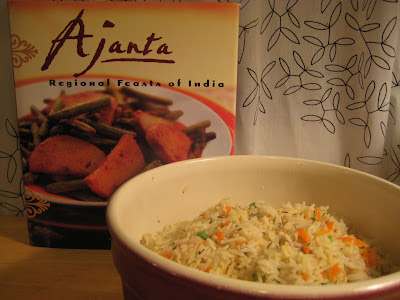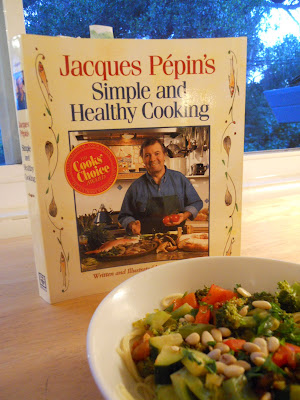Cookbook #10: Ajanta
Adapted from Cookbook #10: Ajanta (2005)
Recipe: Gajar Aur Matar Ka Pulav (Vegetable Pilaf made with Carrots and Peas)
This is the blog entry that celebrates three of my favorite Indian restaurants: Breads of India, Ajanta, and Bombay House.
Let's begin with Breads of India. This tiny little restaurant doesn't have the ambiance of a fine dining establishment, but they make some damn fine gourmet Indian food. They have a myriad of kulcha, chapati, paratha, and naan options (hence the name) that they recommend with each dish, and generally, they don't go wrong. Sprinkle the naan with dill. Stuff the kulcha with chickpeas. Griddle-cook the paratha with ginger. Yes, yes, please to all of the above. The menu switches up daily, and they do take out. Did you see that? They do take out. How many times have the husband and I watched movies from our couch while we ate samosas? Generally our feeling after eating from Breads of India is one of disgust--at ourselves for finishing every last grain of basmati rice out of the take out box. But it is one of the most gloriously satisfying feelings of revulsion.
For a more elegant experience, we head to Ajanta. And they come with their own cookbook (Breads of India, please take note). Two dear Berkeley friends who understand the importance of knowing where to find good Indian in the East Bay gave the Ajanta cookbook to us for our wedding. Oh, there are many places to choose from, but Ajanta on Solano ranks up there as one of the best. Ajanta changes its menu every month to accommodate what's in season, and seriously, Tandoori Asparagus? What's not to love? Our friends gave us an accompanying spice box along with the cookbook, and hoo-whee, this has been a wonderful wedding gift that has kept on giving, even almost four years into our marriage. While the spice box is completely empty, as we tried out as many recipes as we could, the box introduced us to a plethora of Indian spices that I have not used much before, including fenugreek, ajwain, black sea salt, and black cumin seeds. The cookbook is also arranged by region and shows you just what to serve when you want six-course meal from Kashmir, Punjab, Goa, or Rajasthan.
Finally, I want to give some props to Bombay House. Don't go looking for this one in the Bay Area, my friends, for this restaurant is in Salt Lake City. Yes. Salt Lake City. When I was in graduate school, I spent a lot of time at Bombay House, eating pappadams and saag aloo. Thank you, Bombay House, for bringing good Indian food to Utah. And to me. My belly appreciated it.
Let's bring it back to page 210, shall we? Black cumin seeds, called for in this recipe, are what make this pilaf much more than just some basmati rice with peas and carrots. Apparently, Mohammed said that black cumin cures every disease but death itself. Don't let the name fool you: black cumin has a taste that is entirely different from the cumin we all know and love in Mexican and other Indian dishes. Black cumin's scientific name is Bunium persicum. The more common cumin is from the Cuminum cyminum plant. Black cumin seeds are very dark, thin, and crescent shaped when whole. Quite unlike common cumin's dusty brown ovals. The resulting pilaf is perfume-y, rich, sweet, and distinctive. In all the good ways. You should look for black cumin seeds in Indian groceries.
We served this pilaf with raita and a chicken in a black pepper sauce (and we didn't serve it on a Saturday morning, when I am finally getting around to posting this. No, we served it on a Thursday night). Every chicken dish I have made from this cookbook has made me undeniably happy. You might just think about picking up this cookbook for those alone; from chicken in a green herb sauce to chicken curry from Hyderabad, the cookbook's writer and the restaurant’s owner Lachi Moorjani has not led me astray. Well, he does always recommend obscene amounts of red pepper in the recipes, but that just might be my wimpy palate. And if you have never made naan before, this is the cookbook to teach you, with easy step-by-step instructions that keep you in the kitchen by a warm oven all day, which isn't a bad thing when it's foggy and cold outside. I speak from experience.
----------------------------------
Yield:
6-8 servings
Ingredients:
2 tablespoons vegetable oil
2 teaspoons black cumin seeds
2 cups basmati rice
4 cups water
2 teaspoons salt (or to taste)
5-6 bay leaves
1 cup peas (fresh or frozen)
1 cup grated carrots (about one large carrot)
Instructions:
1. In a heavy 6- to 8- quart saucepot, heat the oil. When hot, add the black cumin seeds. Fry the seeds for about 10 seconds and then add the rice. Sauté for about 4 to 5 minutes or until rice begins to brown a little.
2. Add water, salt, and bay leaves. (If using fresh-shelled peas, add them at this time). Bring to a boil, reduce heat, cover and cook for about 8 to 10 minutes.
3. Add peas and grated carrots. Mix, cover, and cook for another 5 to 7 minutes, or until all the liquid is absorbed. Fluff the rice with a fork.
Recipe: Gajar Aur Matar Ka Pulav (Vegetable Pilaf made with Carrots and Peas)
This is the blog entry that celebrates three of my favorite Indian restaurants: Breads of India, Ajanta, and Bombay House.
Let's begin with Breads of India. This tiny little restaurant doesn't have the ambiance of a fine dining establishment, but they make some damn fine gourmet Indian food. They have a myriad of kulcha, chapati, paratha, and naan options (hence the name) that they recommend with each dish, and generally, they don't go wrong. Sprinkle the naan with dill. Stuff the kulcha with chickpeas. Griddle-cook the paratha with ginger. Yes, yes, please to all of the above. The menu switches up daily, and they do take out. Did you see that? They do take out. How many times have the husband and I watched movies from our couch while we ate samosas? Generally our feeling after eating from Breads of India is one of disgust--at ourselves for finishing every last grain of basmati rice out of the take out box. But it is one of the most gloriously satisfying feelings of revulsion.
For a more elegant experience, we head to Ajanta. And they come with their own cookbook (Breads of India, please take note). Two dear Berkeley friends who understand the importance of knowing where to find good Indian in the East Bay gave the Ajanta cookbook to us for our wedding. Oh, there are many places to choose from, but Ajanta on Solano ranks up there as one of the best. Ajanta changes its menu every month to accommodate what's in season, and seriously, Tandoori Asparagus? What's not to love? Our friends gave us an accompanying spice box along with the cookbook, and hoo-whee, this has been a wonderful wedding gift that has kept on giving, even almost four years into our marriage. While the spice box is completely empty, as we tried out as many recipes as we could, the box introduced us to a plethora of Indian spices that I have not used much before, including fenugreek, ajwain, black sea salt, and black cumin seeds. The cookbook is also arranged by region and shows you just what to serve when you want six-course meal from Kashmir, Punjab, Goa, or Rajasthan.
Finally, I want to give some props to Bombay House. Don't go looking for this one in the Bay Area, my friends, for this restaurant is in Salt Lake City. Yes. Salt Lake City. When I was in graduate school, I spent a lot of time at Bombay House, eating pappadams and saag aloo. Thank you, Bombay House, for bringing good Indian food to Utah. And to me. My belly appreciated it.
Let's bring it back to page 210, shall we? Black cumin seeds, called for in this recipe, are what make this pilaf much more than just some basmati rice with peas and carrots. Apparently, Mohammed said that black cumin cures every disease but death itself. Don't let the name fool you: black cumin has a taste that is entirely different from the cumin we all know and love in Mexican and other Indian dishes. Black cumin's scientific name is Bunium persicum. The more common cumin is from the Cuminum cyminum plant. Black cumin seeds are very dark, thin, and crescent shaped when whole. Quite unlike common cumin's dusty brown ovals. The resulting pilaf is perfume-y, rich, sweet, and distinctive. In all the good ways. You should look for black cumin seeds in Indian groceries.
We served this pilaf with raita and a chicken in a black pepper sauce (and we didn't serve it on a Saturday morning, when I am finally getting around to posting this. No, we served it on a Thursday night). Every chicken dish I have made from this cookbook has made me undeniably happy. You might just think about picking up this cookbook for those alone; from chicken in a green herb sauce to chicken curry from Hyderabad, the cookbook's writer and the restaurant’s owner Lachi Moorjani has not led me astray. Well, he does always recommend obscene amounts of red pepper in the recipes, but that just might be my wimpy palate. And if you have never made naan before, this is the cookbook to teach you, with easy step-by-step instructions that keep you in the kitchen by a warm oven all day, which isn't a bad thing when it's foggy and cold outside. I speak from experience.
----------------------------------
Yield:
6-8 servings
Ingredients:
2 tablespoons vegetable oil
2 teaspoons black cumin seeds
2 cups basmati rice
4 cups water
2 teaspoons salt (or to taste)
5-6 bay leaves
1 cup peas (fresh or frozen)
1 cup grated carrots (about one large carrot)
Instructions:
1. In a heavy 6- to 8- quart saucepot, heat the oil. When hot, add the black cumin seeds. Fry the seeds for about 10 seconds and then add the rice. Sauté for about 4 to 5 minutes or until rice begins to brown a little.
2. Add water, salt, and bay leaves. (If using fresh-shelled peas, add them at this time). Bring to a boil, reduce heat, cover and cook for about 8 to 10 minutes.
3. Add peas and grated carrots. Mix, cover, and cook for another 5 to 7 minutes, or until all the liquid is absorbed. Fluff the rice with a fork.









Thanks for the compliments. Please visit Breads of India, Berkeley and see the changes we made to the dining hall recently.Your comments encourage us to keep doing the best possible. The cook book is taking shape and we will keep you updated. Thank you once again,
ReplyDeleteRohit Singh, Chef/Owner